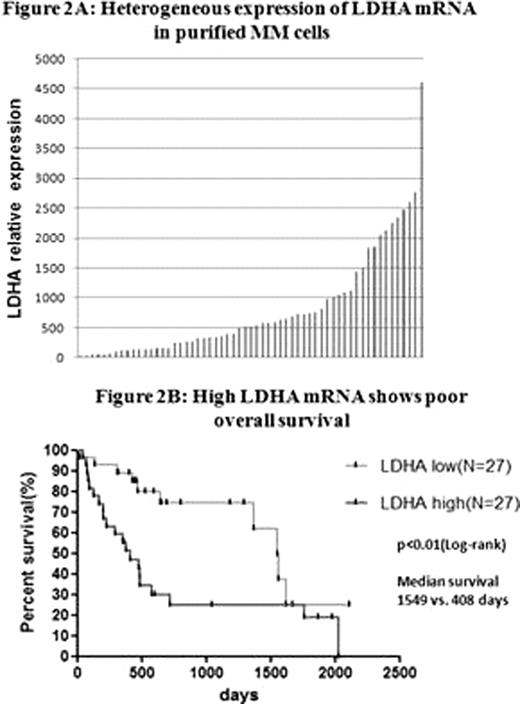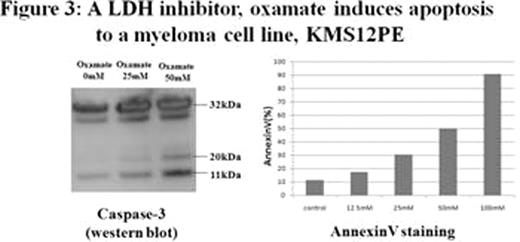Abstract
Abstract 1799
A number of studies have shown that the high level of serum lactate dehydrogenase (LDH) serves as an indicator for poor prognosis in multiple myeloma (MM). LDH is a key enzyme for glycolysis converting pyruvate to lactate, which is eventually utilized as an energy source particularly in tumor cells. It has been reported that cancer cells utilize this glycolysis pathway even in the presence of adequate oxygen to provide cancer cells with energy, called the Warburg effect (aerobic glycolysis). Myc is known to regulate LDH and pyruvate dehydrogenase kinase 1 (PDK1), which are master regulators of glycolysis (Figure 1). Although myc is a well known gene expressed in MM cells, there has been no report analyzing its association with the glycolysis-regulating genetic system, which is located downstream to the myc gene, in MM cells. In the present study, we examined if the glycolysis system is directly or indirectly associated with the survival of MM cells.
MM cells were purified from primary bone marrow samples from 54 patients using CD138-magnetic beads. Written informed consent was obtained from all cases. Seven MM cell lines, RPMI8226, U266, KMS12BM, KMS12PE, KHM11, KMM1 and KMS11, were employed. Five genes associated with glycolysis, i.e., c-MYC, GLUT1 (glucose transporter 1), LDHA (LDH-encoding gene), hypoxia induced factor-1 alpha (HIF1a) and PDK1, were examined using real time PCR analysis. Glucose consumption and lactate production in culture supernatants of MM cell lines were analyzed. Oxamate, a competitive inhibitor of LDHA, was utilized to quantify cytotoxic effects on MM cells. Cytotoxicity was evaluated with AnnexinV/PI staining.
Heterogeneous expression of LDHA gene was observed (Figure 2A). High LDHA mRNA expression levels significantly correlated with poor survival (Figure 2B, p<0.01). A significant correlation between serum LDH levels and the mRNA expression levels of LDHA, was also found (p<0.01). Moreover, LDHA mRNA expression was significantly higher in MM cells than in plasma cells from patients with monoclonal gammopathy of undetermined significance (MGUS) (p<0.01). LDHA expression levels correlated with the expression levels of (i) c-MYC (p<0.0001) (ii) PDK1 (p<0.0023), a key enzyme regulating the Warburg effect, and (iii) GLUT1 (p<0.0003), while it did not correlate with HIF1a expression. It was also found that the greater glucose consumption, the greater lactate production as well as LDH activity in MM cell lines with higher LDHA mRNA expression. Finally, we found that an LDH-inhibitor, oxamate, activated caspase-3 (Figure 3) and induced apoptosis in MM cell lines as well as primary MM cells.
Our results suggest that aerobic glycolysis (the Warburg effect) is up-regulated in MM cells of patients with high serum LDH levels and that the aberrant expression of LDHA, PDK1 and GLUT1 is critical for the survival of MM cells with high serum LDH levels. Thus, aerobic glycolysis itself could serve as a novel therapeutic target in MM patients. Since MM with high serum LDH is with poor prognosis even after the advent of new agents, the present data might have a clinical relevance and might open a new avenue to develop novel therapeutic modalities for treating MM with high serum LDH levels.
No relevant conflicts of interest to declare.
Author notes
Asterisk with author names denotes non-ASH members.




This feature is available to Subscribers Only
Sign In or Create an Account Close Modal